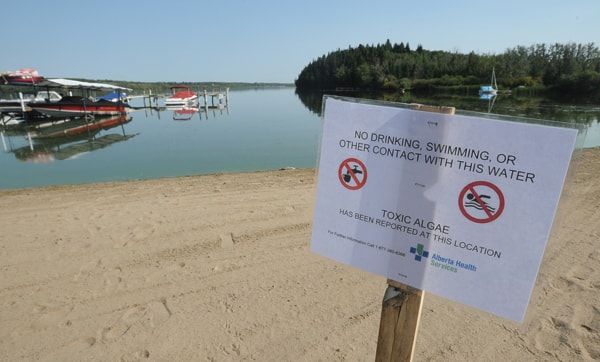Toxins produced by blue-green algae blooms in lakes, including the region’s own Pine Lake, have potential implications for human health, a national study revealed.
A study published by 16 scientists in the Canadian Journal of Fisheries and Aquatic Science on Tuesday surveyed more than 250 lakes across the country.
The researchers found the highest concentrations of potent liver toxins, known as microcystins, were found in many of Alberta’s lakes.
Diane Orihel, lead author of the study and PhD candidate with University of Alberta’s Department of Biological Sciences, said all of the water samples that were collected from Pine Lake — a popular spot among swimmers, boaters and water-skiiers about 44 km southeast of Red Deer — had detectable concentrations of microcystins.
Believed to cause cancer in humans, microcystins are produced by blue-green algae. Algae growth is dependent on the availability of nitrogen and phosphorous.
“The data we have for Pine Lake is that often the (microcystins) levels are low and not a concern but when you have an accumulation of the algae blooms along the shoreline you can get situations where you have concentrations above drinking water guidelines,” Orihel said.
“A big concern is also with pets, if they drink at the shoreline and get a potent dose.”
Orihel said the link between pollutants, such as sewage, runoff and fertilizers, and algae blooms is widely known.
However, what scientists recently found is that high doses of microcystins can cause liver hemorrhages and, possibly, cancer.
“Especially in Alberta, drinking the water or having recreational contact with the water of some of the lakes can be a concern at high enough doses,” Orihel said.
She says they have also learned that concentrations of the toxins peak in lakes where natural wetlands and vegetation have been removed from the shoreline.
“When we take out the vegetation we are stopping the last line of defence for the lake,” she said.
In Alberta about 45 lakes were surveyed in the study. Sturgeon, Haig and George lakes were among the lakes with the highest amount of microcystins.
Microcystins were also found in Blackfalds Lake, a small lake located east of the town but not normally used for recreational purposes.
The information is a reminder that more needs to be done to understand the links between algae and microcystins, Orihel said.
Much of the scientists’ understanding of algae booms, she says, has come from a Canadian facility called Experimental Lakes Area (ELA), which the federal government has decided to axe on March 31, 2013.
The facility conducts ground-breaking freshwater research and whole-ecosystem research on environmental problems.
“The fundamental understanding on algae booms and what causes them has come from the ELA,” Orihel said.
“How are we going to address our water quality issues?”
More information can be found at www.saveela.org.
jjones@www.reddeeradvocate.com
